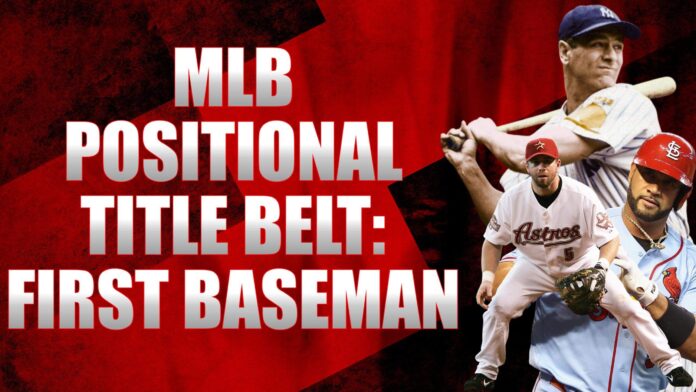Have you ever wondered who the best baseball player alive was in any given year? No? Well, I have. Check out the first article in this series for an explanation of the rules. Next up, First Base. To the list!
Pre-Deadball 1871-1900
At the beginning of time or around 1871, baseball, more or less as we know it, became a professional sport. The first 29 years are known as “Pre-Deadball” because they preceded the next era, “Deadball” and came before the first World Series. It’s like Baseball’s B.C. Catching has been a glove-first position for most of Baseball’s history and early on there were very few who stood out from the crowd enough to qualify for a belt (from a metric standpoint, I’m requiring that the player reach at least a wcWAR+ of 30.0 to qualify).
Cap Anson 1871-
Baseball’s first star was Adrian Constantine Anson. Known as “Cap” Anson, he played a whopping 27 years of professional ball from a 19-year-old for the Rockford Forest Citys of the National Association to a 45-year-old for the Chicago Colts in the National League. Cap was the class of the sport offensively for most of his career and finished with over 2000 RBIs, 3400 hits, a .333/.393/.445 slash and 134 wRC+. Remarkably, he only struck out 302x over a career spanning over 11,000 plate appearances. His influence extended beyond the sport and it should be noted his racism is often considered one of the driving forces segregating Baseball.
Jake Beckley 1898-
During the latter half of Anson’s career a couple of sluggers vied for second place. Roger Connor and Dan Brouthers put up huge numbers but never exceeded Anson’s longevity. After the three of them retired, it was the steady consistency of Beckley that took the crown. Falling just short of 3,000 hits with over 300 SBs and 1500 RBIs, Beckley’s 20 years only accounted for a single Black Ink point (22 triples in 1890!) but piled up an impressive 117.6 wcWAR+.
Deadball 1901-1919
The Deadball era was known for speed, bat-to-ball skills, terrible fields, horrible defense, and dominant pitching. Due to the dearth of offense, there were a collection of first basemen who had solid careers but few who reached great heights. The era’s belts are split between three stars with a quick cameo.
Dan Brouthers 1904-
Big Dan Brouthers, mentioned above, made a 5-game cameo for John McGraw’s 1905 New York Giants. Per the rules, that made him the best first baseman playing in the league for that year, so he got a brief moment on top. He was an excellent hitter, demonstrated by his 5 batting titles, over 450 doubles, .342/.423/.520 slash, and 156 wRC+. He was the original slugger, leading the league in SLG 6-straight seasons from 1881-86 and then again in 1891. He lacked the longevity of Anson but made up for it with significantly more power.
Jake Beckley 1905-
Beckley took back the crown after Brouthers’ one-year appearance but then retired a few years later at age 39.
Ed Konetchy 1908-
From 1908-1914 there were several solid first baseman active including Harry Davis, Frank Chance, Jake Daubert, and Wally Pipp. Standing barely above them was Ed Konetchy, a steady contributor across 15 years. He had limited Black Ink but did lead the short-lived Federal League in total bases with the Pittsburgh Rebels in 1915.
George Sisler 1915-
Ironically, while Knoetchy was reaching his career heights, a beast debuted and took his crown. Gorgeous George played well into the Liveball era and reached what one contemporary called “Cobbesque” heights. A proficient pitcher, he quickly transitioned to the field and became a superstar. He finished the 1920 & 1922 seasons at .407 & .420 batting averages respectively and won the 1922 MVP. His 257 hits in 1920 were the major league record for 84 years and still lead the senior circuit. A sinus infection impacted his vision and he lost the 1923 season. When he returned he was a shell of himself but still finished with 2800 hits, 425 doubles, and a lifetime .340 average.
Liveball 1920-1941
Ruth symbolized the transition from Deadball to Liveball as he began hitting baseballs over fences in great numbers. The twenty-one years that followed saw the sport grow in popularity before reaching a critical point in American history and pushing into the next era, Integration. Ruth’s teammate and perhaps his greatest rival stood as the two great first basemen of the era.
Jimmie Foxx 1922-
Double X, Jimmie Foxx, was the muscle in the middle of Connie Mack’s fabulous 1920s A’s dynasty. One of the game’s greatest sluggers, Foxx was described by a contemporary as being so strong, even his hair had muscles. Despite playing concurrently with the Babe himself (and the next title belt holder), Jimmie piled up 59 Black Ink, a triple crown in 1933, three MVPs, and truly absurd power numbers. His 58 HRs in 1932 is 12th all-time for a single season and was only bested by Ruth prior to Maris’ 61 in ‘61. He slashed a magnificent .325/.428/.609 for a 156 wRC+ and would’ve dominated the title belt for two decades if it hadn’t been for the next guy.
Lou Gehrig 1923-
Debuting a single year after Double X was the Iron Horse. Famously, Wally Pipp had a headache and his replacement happened to be the greatest first baseman of all-time, tough luck Wally. Batting behind the Babe was the hulking mass of a man Henry Louis Gehrig. Actually he was 6’0”, 200 lbs but he’s described as a huge presence because of the wallop he had in his bat. He hammered out 534 HRs and exceeded 40 5x, secured the 1934 triple crown, a pair of MVPs, and fell just 5 RBIs short of 2000. Considering he wasn’t full-time till his age-22 season and retired at age 36 due to ALS, it’s truly astounding he accrued 256.6 wcWAR+ in just 14 full seasons. He’s one of only 10 men (including Foxx and Ruth) to finish his career with an OPS over 1.
Jimmie Foxx 1940-
Due to Gehrig’s tragic illness and premature retirement. Foxx regained the crown and held it for the remainder of the Liveball Era and into Integration.
Integration 1942-1960
Jackie Robinson, Larry Doby, Roy Campanella, Hank Aaron, Willie Mays, Satchel Paige and so many more burst into the major leagues as the color barrier fell. Their brilliance and impact were immense in their own right and furthered the disappointment that so many greats toiled in obscurity behind the veil, such as Josh Gibson, Bullet Rogan, and Oscar Charleston.
Johnny Mize 1946-
Johnny “The Big Cat” Mize started his career in the middle of the Live Ball era and led the league in slugging three years in a row. Then he went off to serve his country in WWII and when he returned he was the class of the first base position for the next seven seasons. His best post-war season came in ‘47 when he clobbered 51 HRs, drove in 138, and slashed .302/.384/.614 for a 154 wRC+.
Harmon Killebrew 1954-
Mize hung up his cleats in ‘53 and the following year a young slugger from Idaho debuted. Harmon Killer Killebrew didn’t take over full-time till ‘59 but proceeded to lead the league in HRs 6x and launch 573 in total. He played all the way to 1975 and picked up the ‘69 MVP with 49 HRs, 140 RBIs, and a .276/.427/.584 slash for a 173 wRC+. Harmon only held the crown for a few years though before it was taken by the league’s greatest Expansion Era first baseman.
Expansion 1961-1976
In 1961, the Los Angeles Angels and Washington Senators (Texas Rangers) joined the league. Then in ‘62 the New York Mets and Colt .45’s (Houston Astros) joined. Again in 1969 four more teams were added, the Kansas City Royals, Montreal Expos, San Diego Padres, and Seattle Pilots (Milwaukee Brewers). There have been three other expansion years but the sudden influx of major league roster spots in the 60s and 70s had competing effects of diluting the talent pool and giving more players opportunities to shine. One of the greatest players in San Francisco Giants’ history stood atop the heap at 1B for the entire era.
Willie McCovey 1959-
Big Mac McCovey continued the trend of slugging first basemen, launching 521 HRs over his 22-year career. While Killebrew was getting MVP honors in the AL, it was McCovey in the NL with a .320/.453/.656 slash, 45 HRs, 126 RBIs, and an incredible 194 wRC+. The bay over the right field fence at Oracle Park is affectionately named McCovey Cove to celebrate his enormous power. He played until 1980 and he shut out other greats such as Dick Allen and Tony Perez but lost the crown to a switch-hitter from LA.
Free Agency 1977-1993
As the Mariners and Blue Jays were added signaling the end of the expansion era in ‘77, the reserve clause fell in ‘75, and a new Basic Agreement went into effect in ‘76, Players were now free to move around the league. Longevity and consistency were the hallmarks of the Free Agency Era’s first baseman.
Eddie Murray 1977-
Steady Eddie Murray went to Cal St. and was drafted by the Orioles. He won the Rookie of the Year in ‘77 and was as consistent as could be for the next 21 seasons. He is still considered the all-time leader in Sacrifice Flies, though the stat has not been kept for the entire history of the game. Murray piled up 504 HRs, 560 doubles, and 3255 hits on the way to the HOF. He is one of the greatest switch-hitters to ever play the game.
Wild Card 1994-2011
After the disaster, which I blame on Bud Selig personally, of the ‘94 stoppage, the players and owners agreed to add more playoff teams, restructure the league, and it took the shape of the “modern” game. This era could also be called the Steroid Era but I went with Wild Card. In an era defined by big sluggers and extreme power, two first basemen held the top spot for almost the rest of league history.
Jeff Bagwell 1991-
Between McCovey and Jeff Bagwell, greats such as Keith Hernandez, Will Clark, Mark McGwire, Rafael Palmeiro, Fred McGriff, John Olerud, and Jim Thome never held the belt. Bagwell was a special breed of hitter, at his peak he had four straight seasons of a wRC+ over 160 smack dab in the middle of the steroid era. He was also sneaky fast for a first baseman and recorded two 30/30 seasons. His career was relatively short at only 15 seasons, but he still managed 449 HRs, 1529 RBIs, and a .297/.408/.540 slash.
Albert Pujols 2001-
As Bags career was slowing down, a young corner infielder from the Dominican Republic debuted for the Cardinals. Prince Albert, or The Machine, put up insane numbers for the first twelve years of his career. Foot injuries left him a shell of himself for the next twelve but he still ended up in the Pantheon of Baseball all-time with 703 HRs, 1914 RBIs, 3384 hits, and a wcWAR+ of 200.8. Three MVPs, a Rookie of the Year award, a batting title, and 46 Black Ink points ensure he’ll be enshrined in Cooperstown.
Expanded Playoffs 2012-Now
Coming up with a name for the current era was difficult. It hasn’t quite been long enough to truly evaluate the years since they added another playoff team. Rules have changed, teams have changed names and divisions, and the game has rapidly transformed into an extremely efficient display of athleticism and power. For nearly the entire era Pujols was the best but he retired last year so we can honor one more great.
Miguel Cabrera 2023-
While he debuted as a left fielder and spent a large portion of his career manning third, Miguel Cabrera has played nearly half of his career games at first. What a career it has been, likely playing his last season, Miggy already has 620 doubles (14th all-time), 508 HRs, 1864 RBIs, and 3140 hits. He’s won four batting titles and the last major league triple crown in 2012, the first of back-to-back MVPs. After Miggy, it’s a two-horse race for the title belt between Paul Goldschmidt & Freddie Freeman, both with plenty of career left to make their case.
So there you have it, the first base title belt holders:
Cap Anson 1871-1897
Jake Beckley 1898-1903
Dan Brouthers 1904-1904
Jake Beckley 1905-1907
Ed Knoetchy 1908-1914
George Sisler 1915-1921
Jimmie Foxx 1922-1922
Lou Gehrig 1923-1939
Jimmie Foxx 1940-1945
Johnny Mize 1946-1953
Harmon Killebrew 1954-1958
Willie McCovey 1959-1976
Eddie Murray 1977-1990
Jeff Bagwell 1991-2000
Albert Pujols 2001-2022
Miguel Cabrera 2023-2023







